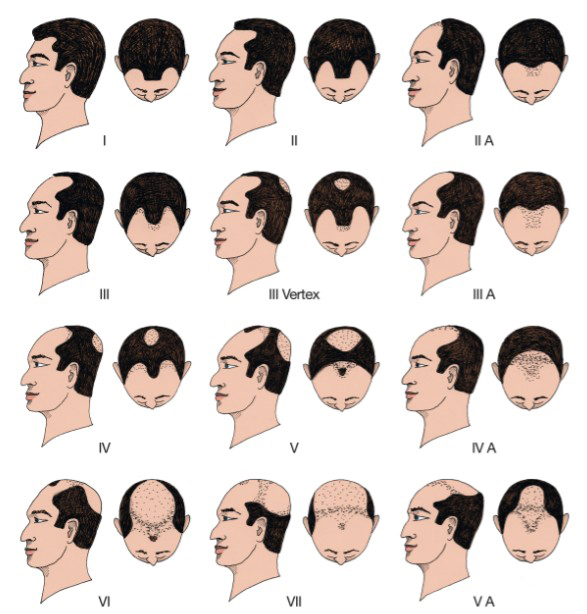ALOPECIA
Alopecia may have numerous causes. Finding the right one is the first step to a successful therapy.

Alopecia may have numerous causes. Finding the right one is the first step to a successful therapy.
Androgenetic alopecia or hereditary hair loss is the most common cause of thinning hair and progressive balding. The cause of this kind of alopecia is the heredity of hormone receptors at the top and frontal part of the scalp that react sensitively to male hormones. As time progresses, the hair at the top of the head will grow thinner and finally disappear. Hereditary hair loss usually does not affect hair at the back of the head.
Hereditary hair loss affects about half of all men worldwide. The individual extent depends on the genetic predisposition.
According to Norwood/Hamilton, androgenetic, male-pattern baldness is divided into seven individual stages:

In many cases, hereditary male-pattern hair loss can be stopped by medical therapy. Men with patterned baldness type 2-6 are usually good candidates for hair restoration surgery. When a surgical treatment is planed, further hair loss of the pre-existing hair has to be taken into consideration. The donor supply at the back of the head determines how many grafts can be planed over time.
About one third of women worldwide suffer from androgenetic alopecia. As opposed to men, women rarely develop baldness; instead, the hair at the top of the head grows thinner.
Hereditary, female pattern hair loss can essentially be divided into four individual stages.

Women who are type II on the Ludwig scale and have a so-called Christmas tree pattern are generally well-suited for a hair restoration surgery. The cosmetic result is crucially determined by the hair thickness and density of the donor area at the back of the head.
Alopecia areata or patchy hair loss is an inflammatory condition where circular hairless spots on the head, in the beard, of body may develop or even a complete loss of all head and body hair may occur (alopecia areata totalis/universalis). It is estimated that about 2% of the world population are affected by alopecia areata. The causes of alopecia areata have not been sufficiently identified yet. It is assumed that alopecia areata is an autoimmune disease, which means that the immune system turns on the patient’s own hair. Alopecia areata cannot be treated by hair transplantation. Patients with hereditary hair loss and alopecia areata may only be operated on when the alopecia areata has resolved. Otherwise, there would always be a risk of alopecia areata being reactivated and of losing the transplanted hair.
For further information on alopecia areata visit:
www.naaf.org
www.kreisrunderhaarausfall.de
We speak of acute hair loss (acute telogen effluvium) if there is a sudden increase in the loss of hair (more than 100 hairs a day). Those who are afflicted often report losing whole tufts of hair, brushes filled with hair, and sinks that clog up when they wash their hair. There are numerous potential reasons for telogen effluvium. The most frequent causes include thyroid issues, iron deficiency, vitamin deficiency, and acute stress. Telogen effluvium may coincide with hereditary hair loss and even lead to formerly subtle hereditary hair loss becoming obvious. Before a hair transplant is taken into consideration, any causes of telogen effluvium need to be removed and the acute loss of hair needs to be stopped.
Scarring hair loss or cicatricial alopecia is a group of rare, inflammatory diseases leading to spots of permanent hair loss and leaving scars. The causes of scarring hair loss have not been sufficiently identified yet.
Again, it is an autoimmune disease that turns the immune system against the hair stem cells. Patients with cicatricial alopecia can only be treated by hair restoration surgery after the hair loss has been stopped and the inflammation has fully healed. However, there is a risk of the disease being reactivated by the operation or its being rekindled at a later point, resulting in the loss of the transplanted hair. The growth rates of the hair transplants are also usually lower than in cases of hereditary thinning. Nonetheless, experience has shown that a satisfactory cosmetic result can often be achieved.
Scars that are the result of accidents, postsurgical scars or a hereditary lack of hair in small areas (aplasia cutis congentia) can be easily corrected by hair transplantation.
For further information on hair and scalp disorders and treatment of alopecia
check out our YouTube channel:
→ Dr. Nina Otberg die Haarspezialistin
or visit us on Facebook:
→ Otberg Medical